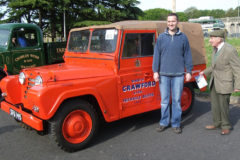David Brown 25D: A powerful performer!
Posted by Chris Graham on 26th March 2021
Robbie Thorpe digs out one of his favourite tractors and explains to Jonathan Whitlam why he has such an affinity with David Brown machines.
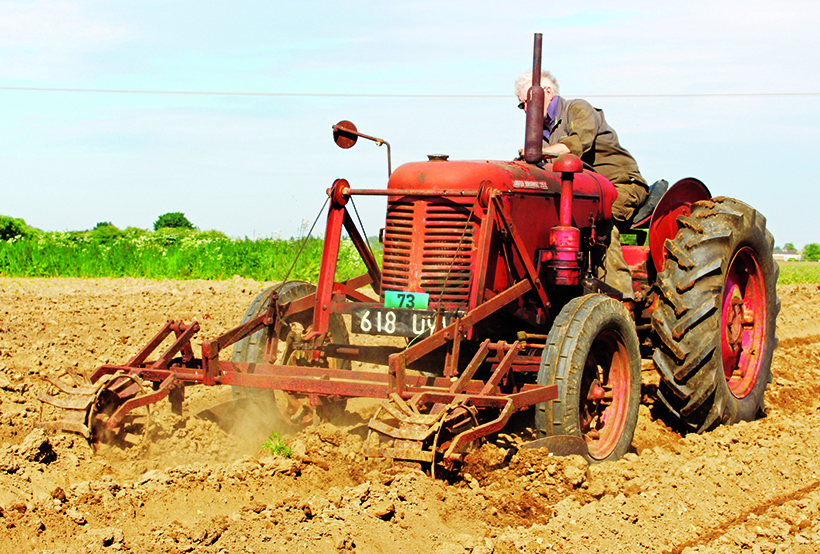
The little David Brown 25D is an ideal tractor for this sort of row crop work, especially after Robbie fitted larger tyres to both the front and rear wheels, allowing it to clear the ridges with ease.
Robbie Thorpe has a large and very varied collection of tractors and machinery at his home in Lincolnshire but, if you push him on the matter, he’ll probably admit that his main affinity lies with the Yorkshire-built David Brown machines. After all, he still owns his grandfather’s David Brown Cropmaster, that was bought new back in 1951, complete with two David Brown ploughs, wheel strakes and a David Brown potato coverer.
This brings us to the subject of this article; a similar but later David Brown creation – a 25D. Robbie kindly got it out of the shed and put it to work for me with the David Brown potato coverer that had been used with his old Cropmaster. Although no potatoes were actually being planted, the machine was just being put through its paces on some specially-drawn ridges, purely for my benefit.
Following the Cropmaster
The design of the David Brown 25D can be traced back even further than that of its predecessor, the Cropmaster, as it was very much an evolution of the original David Brown tractor; the VAK1 of 1939. This original design was developed into the Cropmaster, or VAK1C as it was called in internal David Brown vernacular, introduced in 1947 and soon to become the most popular of the range so far.

The 25D and front coverer sit at the end of the ridges ready to begin work. Normally, this set-up would be following a gang of hand labourers who would be placing seed potatoes or flower bulbs at the bottom of the ridges.
Implements had been a growing feature of the David Brown tractor operation, centred on Meltham Mills near Huddersfield during the era of the Cropmaster. These included ploughs, cultivators and much more, as well as the front-mounted splitter, or as we are calling it, the coverer. The Cropmaster also included the option of a built-in rear power lift as an answer to the Ferguson System offered on the popular TE-20 tractor. In 1949, the Diesel Cropmaster appeared, offering the extra durability of a heavy oil engine.
Significant popularity
The Cropmaster still incorporated the bench seat and ‘scuttle’ around the front of the driving platform that had been introduced on the very first David Brown models. It proved to be an extremely popular and successful machine, with a Prairie Cropmaster variant being launched in 1951; it boasted more ground clearance and was aimed at the North American market.
However, by 1953, it was clear that the Cropmaster needed a radical rethink to keep its popularity going amidst stiff competition from Ferguson and Ford.
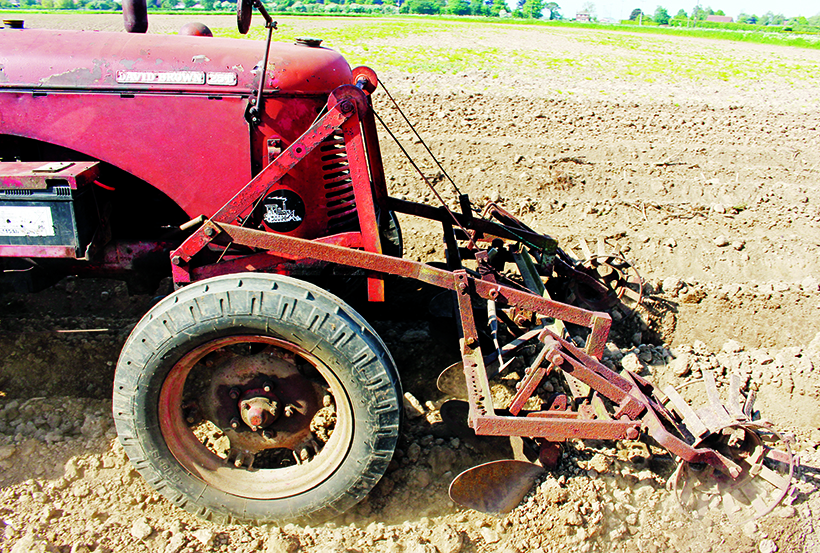
The David Brown coverer in action, breaking up the ridge and moving the soil firmly over the top.
It was also decided to produce two models instead of one, so that the firm could compete with the smaller Ferguson and also the larger Fordson, adequately. Another decision was to strip back the features of the Cropmaster somewhat, creating a cheaper machine to keep it competitive, but still offer the key features that British farmers – in particular – required. So, in March of that year, the new 25, 30C and 30D models were unveiled to the farming public.
The 25D is born
Originally known as simply the 25, this tractor was only available as a petrol or petrol/paraffin machine, as was the 30C. The 30D, meanwhile, was a diesel-powered model. The 25 was a brilliant start to David Brown’s entry into the smaller tractor market, with 25hp available from the four-cylinder engine, plus the benefits of a six-speed gearbox as well as a two-position, hydraulic rear lift. This provided farmers with a relatively cheap but well-specified machine that proved to be a popular choice for many.
The 25 also featured new styling, losing the bench seat and scuttle in favour of a more open driving platform and a single seat. However, with the new layout featuring the clutch pedal to the left and the engine, transmission and steering wheel offset to the right, the driving position was rather awkward.
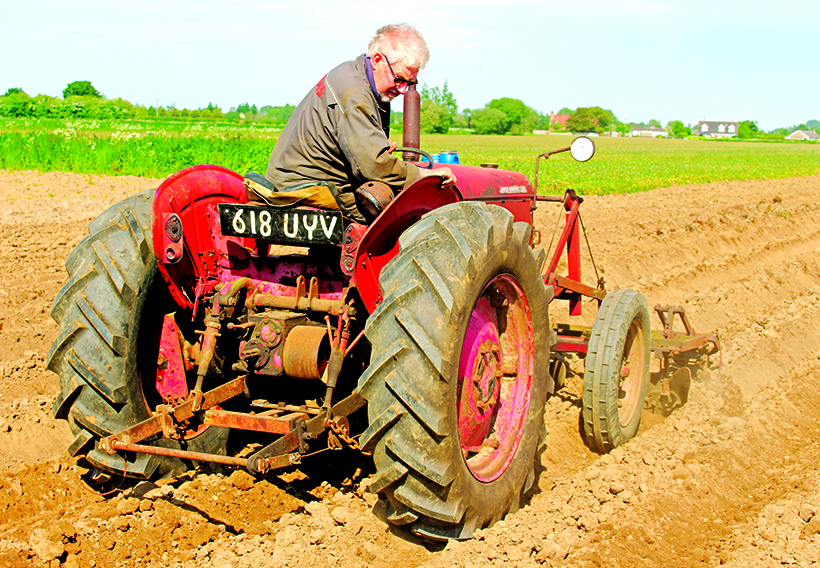
From the rear, the tractor’s linkage and belt pulley are clearly visible. This 25D is also fitted with the David Brown TCU, which made it able to handle much larger implements than comparative tractor models.
Secret weapon
The real secret weapon hidden within the 25 was the addition of a new weight transfer system, called the Traction Control Unit (TCU). This allowed the relatively light 25 to work with heavier implements, and thus do the sort of work usually reserved for larger tractors. It was fitted as standard to all the David Brown tractor range from late 1954.
The larger, 30C and 30D models looked similar to the Cropmaster initially, but soon adopted the new styling of the smaller 25, followed by a new, larger tractor, the 50hp 50D. Then, in late 1953, the 25D was launched, bringing diesel power down to the smallest, conventional tractor in the David Brown range. This then saw the original 25 model re-badged as the 25C.
Power plant
The diesel engine used in the 25D was a variant of the David Brown AD4 unit – designated ‘AD4/25’ in this guise – and it produced just over 30hp. The diesel engines built by David Brown had already proved themselves in the Cropmaster, and were renowned for their efficiency and general reliability. With the 25D, the company had produced a very neat and fairly inexpensive tractor that was, once again, ideal for the needs of British farmers and, thanks to TCU, one that could even outperform the Ferguson, which was the market-leader in that power class.
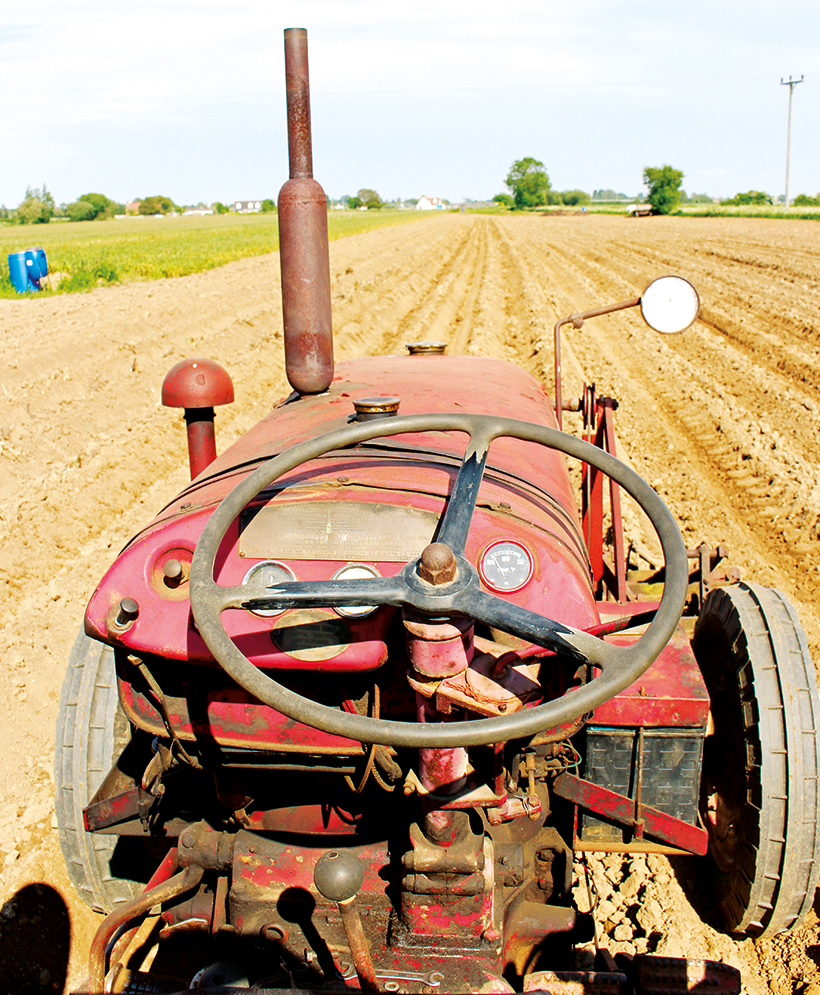
The 25D’s offset driving position is clear see from this angle. As a consequence, the new, central seat position wasn’t ideal!
In 1956, the future of the David Brown tractor range was seen when the new 900 model was launched, with a complete redesign bringing a fresh look and new features. Unfortunately, it proved to be unreliable, and ended up something of a white elephant for the firm. This meant that the existing tractors carried on in production for longer than was probably intended, and it wasn’t until the 950 was introduced early in 1959, that the future of David Brown tractors became a reality. By then, the last 25D at been built – in 1958 – and the first generation of David Brown tractors finally ended.
25D in action
It was great to see this little tractor at work, especially doing something similar to what it did during its working life. The frame that’s fitted to the front – for mounting the coverer on – came with the tractor when Robbie acquired it.
However, little is known about the tractor’s history, although it was local to this part of south Lincolnshire. Robbie bought it almost by accident, as he was actually looking for a two-furrow plough. He went to look at one and spotted the 25D parked next to it. A price was agreed for the pair, and he took them both home!
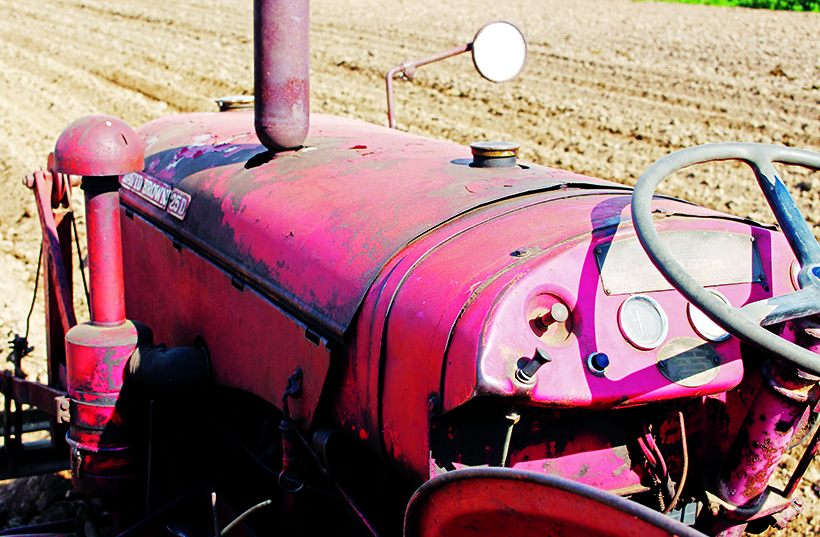
With air intake and cleaner positioned to the offside of the bonnet, forward visibility isn’t compromised. Robbie’s tractor also retains the original brass caps to the fuel tank and radiator, as well as all the original tinwork.
That was quite a few years ago now, and Robbie has done little to the tractor since. He had to re-register it, as the previous owner had the logbook but, unfortunately, died before passing it on to Robbie. Luckily, he managed to get an age-related plate to keep the tractor looking original.
In fact, it’s pretty much original altogether, with just a new starter motor and the usual filters and ancillary items having been replaced over the years. It’s also been fitted with larger front and rear tyres, which help increase the tractor’s ground clearance. Everything works fine on the tractor, including the useful TCU (Traction Control Unit), as Robbie says: “All you have to do is put a battery on her, press the cold start and away you go!”
Old-fashioned
The 25D certainly seems powerful for its quite diminutive proportions. Robbie says that it’s not as handy as, say, a Fordson Dexta or Massey Ferguson 35 and, although it doesn’t bother him much, the offset driving position seems to give a rather more old-fashioned perspective to driving the tractor. However, when travelling on the road, it’s very nippy, and faster than most contemporary machines.

The plate mounted on the dash panel tells you everything you need to know! It also shows just how many patents had been taken out concerning aspects of this tractor’s design.
Although we weren’t actually planting any potatoes – or ‘tates’, as they are known here in Lincolnshire – the front coverer certainly showed that it was an especially useful implement. It split the ridges nicely, and covered the tubers that would have been placed by hand in the bottom of the ridges drawn out beforehand.
Being front-mounted, these implements are much easier to use as they’re much more easily seen from the driver’s seat. What’s more, the 25D’s offset driving position is an asset in this instance, and a good example of why they were produced this way.
‘Cotton reels’
These types of coverer built by David Brown and other manufacturers, were particularly common in Lincolnshire because of the large cropping of potatoes, and also daffodil bulbs. Some were fitted with solid, Diablo-type wheels, or ‘cotton reels’, as Robbie calls them, but this David Brown example is fitted with an open spider-type, which helps to prevent clogging in damp conditions. Three shares then move the soil, splitting the ridges and covering the seed potato tubers sitting at the bottom of the ridge – job done.
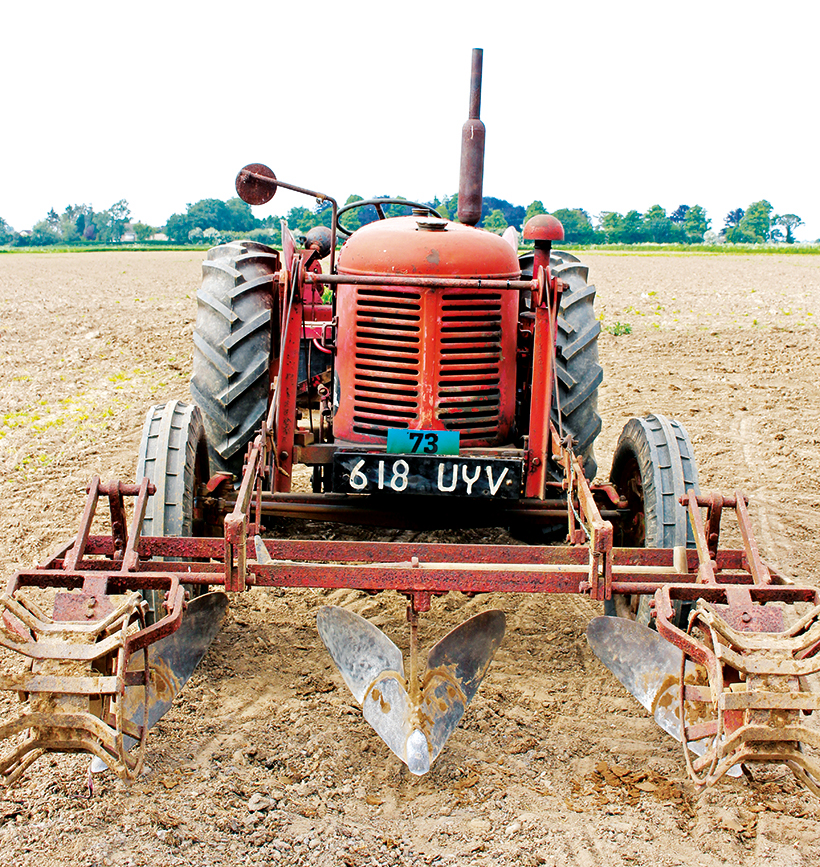
Front view revealing the three shares that break the ridges and fill in the gaps, plus the two Diablo-type wheels with open-pattern design.
The 25D came with the frame left on the tractor, as was often the case when not using the front-mounted implement, and so it was a straightforward matter to fit the existing coverer that had originally been fitted to the Cropmaster. The design of the tractors was similar, in any case. These coverers continued to be produced by David Brown, and were fitted to the much newer Implematic designs that followed the 25D.
Robbie will never part with his grandfather’s Cropmaster, but other David Brown tractors have come and gone over the years, including some more powerful 30D models. One thing’s for sure, though; as long as Robbie keeps ownership of this 25D, he’ll not restore it, preferring to keep it original and able to tell the story of its working life, for all to see.
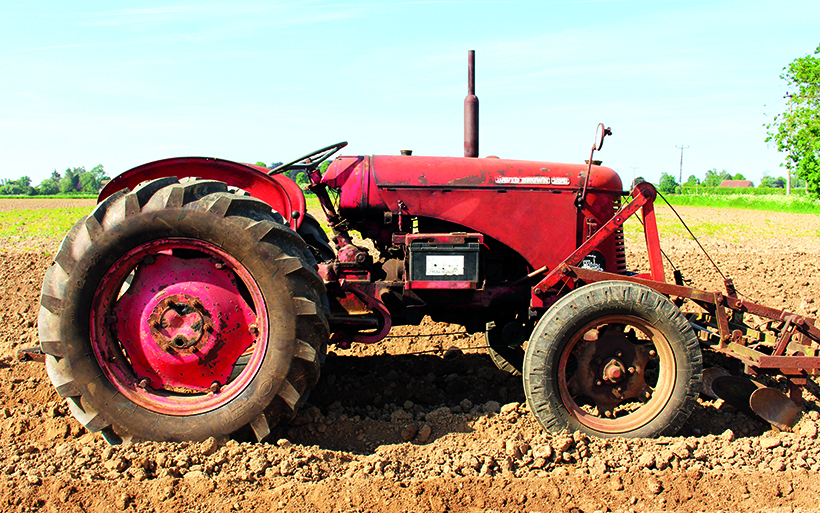
A side view showing the battery position and the compact, overall dimensions of this accomplished tractor.
For a money-saving subscription to Tractor & Farming Heritage magazine, simply click here




